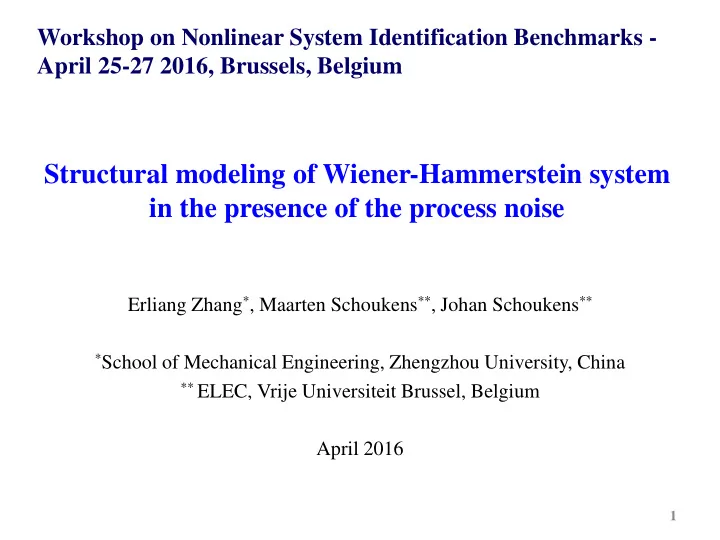

Workshop on Nonlinear System Identification Benchmarks - April 25-27 2016, Brussels, Belgium Structural modeling of Wiener-Hammerstein system in the presence of the process noise Erliang Zhang * , Maarten Schoukens ** , Johan Schoukens ** * School of Mechanical Engineering, Zhengzhou University, China ** ELEC, Vrije Universiteit Brussel, Belgium April 2016 1
Content Problem statement Assumptions Response of the Wiener-Hammerstein system Process noise detection Examples Conclusion 1. 2
Problem statement Fig. 1 Wiener-Hammerstein system Process noise modeling influences the estimation consistency of Wiener- Hammerstein model Detect whether the process noise passes through the static nonlinear part 3
Assumptions Wiener-Hammerstein model (1) The systems R ( q ) and S ( q ) are linear, stable and time-invariant (2) The static nonlinearity f ( t ) belongs to the set of generalized nonlinearities, can be approximated arbitrary well by polynomials in the sense that the mean square error tends to zero as the polynomial degree tends to 1. Measurement and process noise The output measurement noise e y ( t ) and the process noise e x ( t ) are zero-mean stationary noise, and independent of the input excitation. System input The input signal u ( t ) is a persistent excitation, whose value is bounded. 4
Assumptions Static nonlinearity: i f x = a x i i =0 (Weierstrass approximation theorem) Approximately, n f i f x = a x i i =0 5
System response The process noise does pass through the nonlinearity part (see Fig. 1) i -1 i- j i j y t = a S q x t + a c S q x t e t + e t m i i ij x y i =0 i =1 j =0 measurement noise nonlinear system response error due to process noise where x ( t ) = R ( q ) u ( t ), i ! c = i - j (binomial coefficient) ij ! ! j Remark: the error caused by the process noise is “modulated” by the input signal! 6
System response The process noise does not pass through the nonlinearity part i y t = a S q x t + S q e t + e t m i x y i =0 error due to pro cess noise measureme nt noise nonlinear sy stem response where x ( t ) = R ( q ) u ( t ). Remark: the error caused by the process noise is independent of the input signal! 7
Process noise detection Principle Use the stationarity of the ouput measurement noise Use nonstationary input signal to differentiate the output error caused by the process noise from the measurement noise when it passes through the nonlinearity part Use the periodic signal to separate the nonperiodic part (caused by the process noise and measurement noise) from the nonlinearity of Wiener-Hammerstein system Design a periodic signal which is nonstationary within one 8 period
Process noise detection Input design Random phase multisine with Iterative optimization with k as design variables (1) At the i +1 iteration step (2) Compute the DFT (3) Impose constraint RMS 0 : expected enveloppe RMS i : iterated enveloppe at the i -step 9
Process noise detection The output error e p ( t ) caused by the process noise (Preceding the SNL part) (Succeeding the SNL part) Bounded property e p ( t ) is aleatory, and has finite mean-value and variance at each time instant 10
Process noise detection Robust measurement strategy using multiple experiments M experiments, P periods 11
Simulated example Wiener-Hammerstein system Linear systems Static nonlinearity (SNL) where 12
Simulated example Input signal (one period) Sample number N = 8192, 2132 excited frequency lines Periods of signals: P =32, experiments: M = 32 13
Simulated example Wiener-Hammerstein system: heavy output measurement noise Preceding the SNL part 14
Simulated example Wiener-Hammerstein system: heavy process noise Succeeding the NL part 15
Wiener-Hammerstein benchmark Wiener-Hammerstein benchmark with process noise Periods of signals: P = 30 Experiments: M = 32 16
Wiener-Hammerstein benchmark Averaged system response over periods for 32 experiments 0.2 Mean value w.r.t. period 0.1 [m] y t 0 m -0.1 -0.2 500 1000 1500 2000 Temporal data (one period) 17
Wiener-Hammerstein benchmark Standard deviations of output error, including measurement noise + error caused by the process noise, for 32 experiments 0.14 0.12 Standard deviation w.r.t. period 0.1 σ t m 0.08 e 0.06 0.04 0.02 500 1000 1500 2000 Temporal data (one period) 18
Wiener-Hammerstein benchmark Standard deviation of output error over all experiments Averaged standard deviation w.r.t. experiment 0.105 0.1 0.095 0.09 0.085 M 1 σ σ t t e m e M 1 0.08 m 1 500 1000 1500 2000 Temporal data (one period) 19
Wiener-Hammerstein benchmark Physical interpretation of decreasing-increasing behavior of the estimated output error Circuit generated the static nonlinearity 20
Conclusion A simple framework has been proposed for the structural modeling of Wiener-Hammerstein systems with process noise. The proposed methodology can provide insight on the static nonlinearity which the process noise precedes. It can be straightforwardly applied to other block-oriented models. 21
Recommend
More recommend